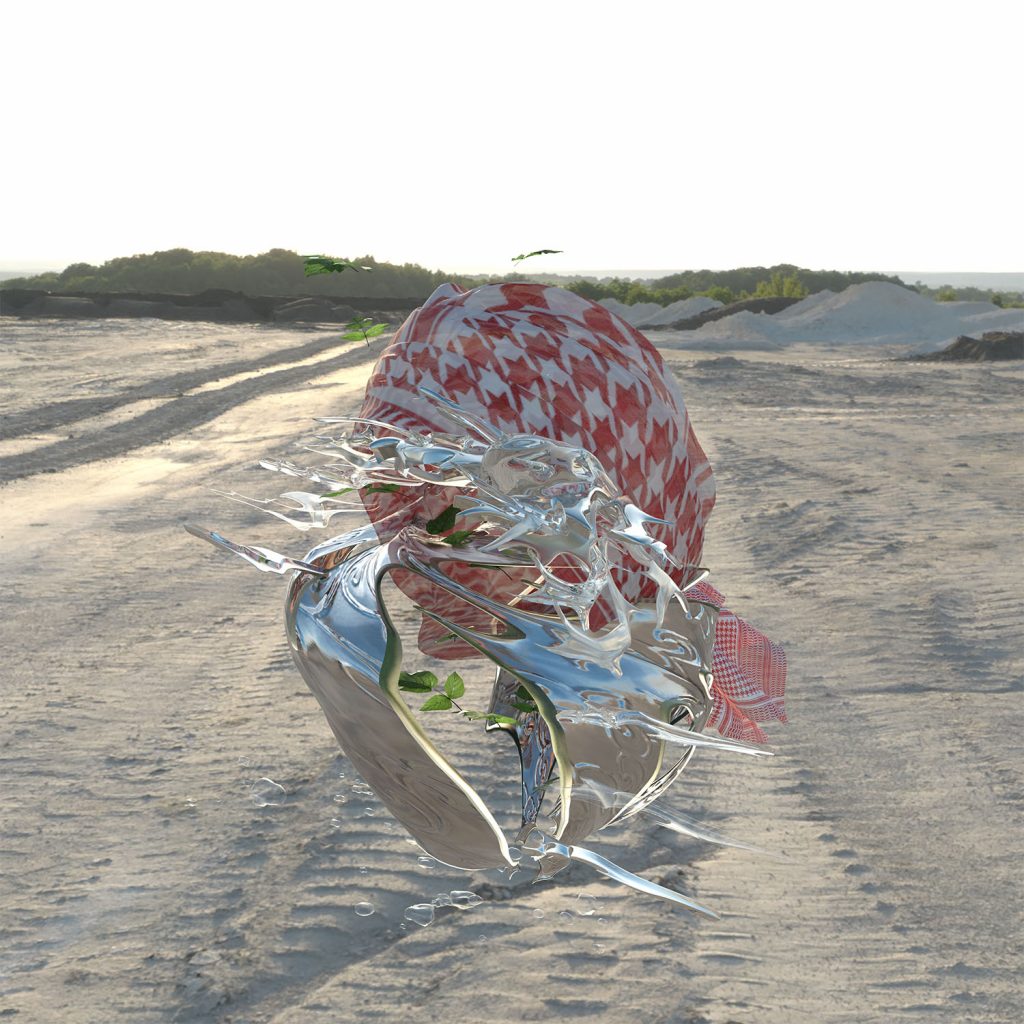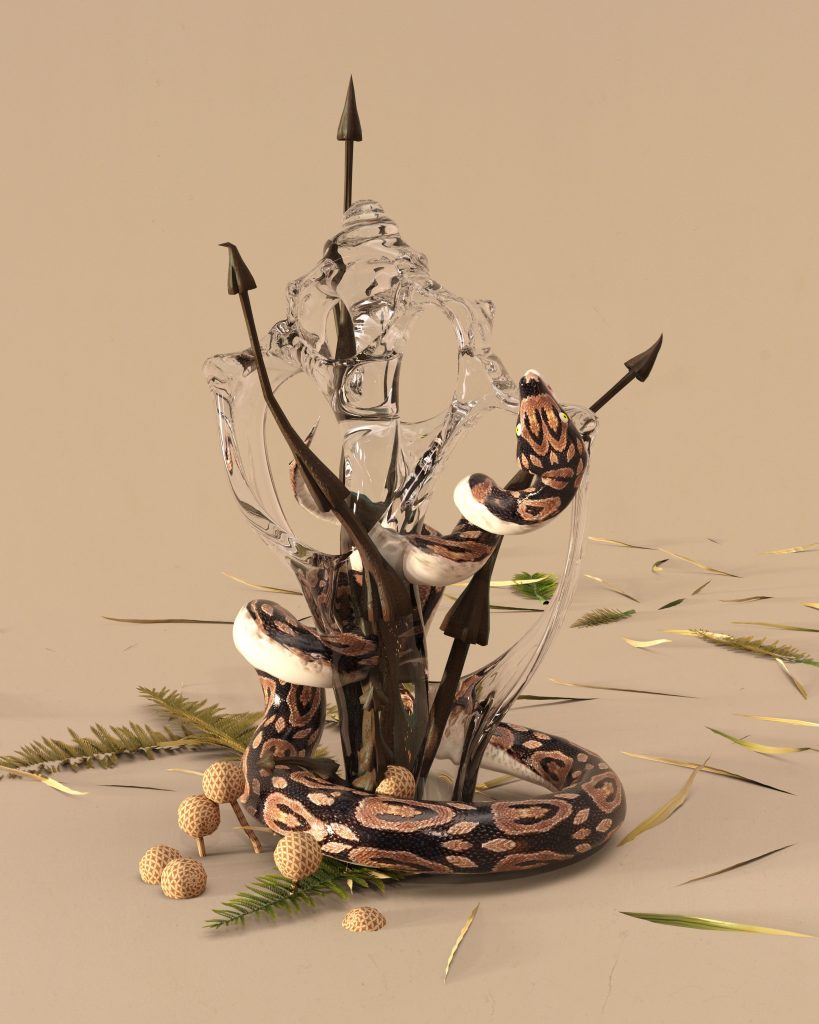“Binaries and balance were the signifiers that stood out to me the most, visually,” writes Helin Şahin via email about the theme of AQNB’s latest Between two stars mini-compendium—inspired by the recently passed Gemini season and released on July 14—for which the US-based artist contributed a typically stunning artwork. “I imagined a state of equilibrium, given through an object with not many boundaries, or an acting force.” Responding to the implied duality of its astrological theme, the dazzling piece features a multi-perspectival CGI sculpture of translucent waves and what looks like hair suspended in motion, obscuring indiscernible coloured objects by its own refracted movement. “I appreciate the glass material’s unexpectedness and dynamism very much; the casting of the colors and reflections in a sumptuous way, but still with a natural flow repeating itself in complex forms everywhere.”

There’s an opacity and abstraction to Şahin’s work that mirrors her relationship to identity. Born and raised in Turkey, the artist’s family is originally from Turkish occupied Northern Kurdistan, which is a heritage she chronicles on her @archivemedina account. There, vital still images of Kurdish people and tradition are collected in their own tableaux vivants, anonymous lives suspended in time but bursting with implication. “There is a deep generational trauma and pain that surrounds the Kurds, as well as other minorities in Kurdistan and the diaspora,” Şahin writes about her private impulse toward collecting these fragmentary glimpses into an ancestry that’s been partially erased by a history of oppression and racism. “I personally had to constantly deal with this instability and anxiety around my identity. Not being able to speak my mother tongue or to learn about my history growing up has brought upon that loss of connection and belonging issues.”
It’s almost as if Şahin has been figuring that out in her work. Depictions of two-dimensionally-rendered, multi-dimensional objects give the illusion of simplicity and beauty but are in reality highly complex and troubled by something obscure and impenetrable. This sense of ambiguity and ambivalence lives in everything Şahin produces, where fluidity is caught in suspension, distinctions between digital and analogue objects are confused, and views and perspectives are disoriented. “These elements are organically assembled into the same space with more formal/familiar ones in true forms, which definitely creates some confusion,” she writes about the simultaneous realities that overlap and collapse into her work. “Most elements do feed off of this contrast though.”
It’s with this view to Şahin’s practice—birthed through sketching and painting and developed via digital art—that one should consider the multidisciplinary artist’s contribution to Between two stars and what she describes in a sentence fragment as “cosmic symbolism… twin stars, different potentials on each side of the balance point—mortal Pollux and the immortal Castor.”

** I’m very into this ‘magic realism’ element to your work. Is that description a label you would apply yourself? Can you tell me something about what influences your approach?
Helin Şahin: Sure, you could say that. Many people ask me if these images are photographs of real-life sculptures I make. It’s confusing to have that dichotomy in your visual language, a partial realistic look with some ‘unreal’ exaggeration. I like replacing the idea of reality and its meanings. I appreciate the work when it hints at the existence of an obscure reality. I’m not a big fan of things that are easily identified or classified.
**I’m interested in what you said about social media being ‘miraculous’ in this small feature published a couple of years ago, what is your relationship to it and how much can you apply your development as an artist to social media?
HS: I think it is miraculous because of how much it has changed the way the industry operates. It definitely made art more accessible and answered the desire for alternative art communities. Especially for artists who work in digital mediums with so little representation. Some of my most interesting projects and collaborations have happened through social media. More broadly, we see so many grassroots movements that began on social media. It’s important to be able tell our stories and get such a massive and rapid response and solidarity.
**I ask, not only because social media as a space for connection, interaction and collaboration is pretty much the norm by now for a certain generation, but because I see you have friendships with other artists that exist in this space. What is your relationship—professional, personal and otherwise—to the internet in general?

HS: There is a huge multidisciplinary artist community I’m a part of. The connection we have on these platforms bring a lot of newness to art and often challenges the aesthetic conformity in the industry. More personally, it helped me vocalize my critical opinions, and contribute more comfortably. I used to be very shy expressing some parts of me publicly, especially regarding identity.
**Having described the loose theme of the Between two stars compendium, I wonder what your relationship is to those symbols and signifiers mentioned, are any of these descriptors—like ‘organic’, ‘earthy, ‘solid’, ‘ungraspable’—ones that you would identify with within your own work?
HS: ‘Organic’, ‘earthy, ‘solid’, ‘ungraspable’ are all definitely some important personal identifiers for me. It’s good to have identifiable, yet inimitably odd forms related to living matter, or to totally fictional narratives. At times, they appear as rigid as a sculpture but definitely with fewer boundaries and more fluidity. All the visual metaphors present are quite open for multiple readings. I’m interested in what they evoke in the viewer.
**You seem rather prolific online, I’m keen to know your process. Do you produce work really rapidly, how does it come to you? Is there much of a conceptual, or intentional approach to these abstractions that you produce?
HS: There really isn’t a specific method behind my process. I could say it as a chain of digital experiments and their shifting; they take place quite immediately. It’s quite spontaneous, very much connected to my subconscious. This flow helps me gain clarity about myself and naturally makes the work very personal. If I know what I want to do after a critical thinking and murmuring period, it’ll go fast. When I’m not working on a personal project though, or if it’s compensated and around a strict theme, the bureaucratic work can consume more time and energy. It can get draining really quick.

**There’s this duality to your work, or something that goes beyond simply being a collapse of physical and virtual realities. Like with the overlapping perspectives on your design, it feels more entangled and interlocked, kind of like the non-orientable surface of a Möbius strip. I’m curious about what your thoughts are on this approach yourself, these multiple perspectives existing in the same space all at once…
HS: I can see why you would think of a Möbius strip. There is this multidimensional single-sided vibe in harmony, more so in the abstract forms. It’s quite unsettled and often challenges the structure imposed on our ways of seeing/reading. I think about it in terms of ‘becomings’—in what you see from different points of focus. I tell it the way I want. For me it helps to escape the limits of perception and experience.**
AQNB’s Between two stars music & art compendium was released on July 14, 2020.













